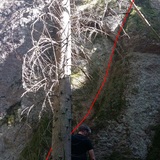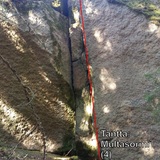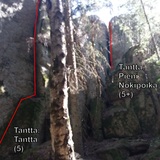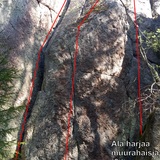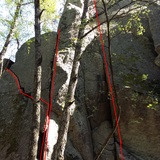The pioneers of Pärkänvuori wanted to keep the crag bolt-free. This baseline has been followed also on developing new routes. Climbing at Pärkänvuori requires the skill of using natural protection, also when building top rope anchors on many routes. The big-crystal cracks at the cliff are not only places for one to shove their limb, though. In addition to the low-angle, sunny southwest face and steep, shady northeast face there is also some cave crawling. On the northwest edge of the crag, on the right side of Poikamies sector, big boulders form a cave called "Pimi kellar". It's been told that the local people were hiding there during the Great Northern War in the 1700's. The holes in the roof of Pimi kellar are work as the entrances to the esoteric "Kasmofilia" (= liking to climb chimney routes) sector. There is no topo of that sector. The longest cave divings are over 10 meters deep. Find yours but don't get stuck!
https://jammi.net/kalliot/parkanvuori/index.html
The rumbling sound of enormous boulder blocks has been heard in the geological history of Pärkänvuori. According to an old legend, a young couple from Lokalahti were on their way to the church of Vehmaa village, to receive their banns of marriage. They traveled with a horse carriage along the northeast side of the crag, where the road used to go at those times. Suddenly a huge boulder started to avanlance from the top of the crag. The couple never ended up married - their smashed bodies are decomposing under the rock. Since then, the boulder has been known as The Bridal Rock and the whole crag as The Bridal Crag. Next to The Bridal Rock is something even more impressive: a giant sharp-ridged boulder which has fallen apart from the main crag, creating a big, open cave. The local residents started to call the cave as "Veskellar".
During ther 1960's there were plans to mine some construction blocks and gravel from the granite of Pärkänvuori. The Bridal Rock was used as a loading bridge for lorries. Those rock mining plans were then forgotten. That was lucky for this "mother crag" of the Southwestern Finland rock climbing. The first climber found the crag in 1994. However, the finder, Riku Mattila, considered the walls of Pärkänvuoi more or less impossible to climb. That impossibility turned out to be an illusion and Pärkänvuori got it's first routes in 1997. During the following summer seasons there were a lot of activity at the southwestern wall of the crag and many first ascents were made. Back then Antti Noramaa, along the others, was making the routes which were based on the crack formations on the crag and use of natural protection. In addition to those "trad routes", Mikko Söderlund took advantage of the potential of the northeastern wall to create a series of challenging aid routes. The foundations and signs for the future of Southwestern crack climbing had been set. One of the cycles of Pärkänvuori was closed in 2008 when Perttu Ollila made the free ascent of the aid route "Trad Master", completing the trio of three close-to-each-other "mega routes" at the northeastern wall of the crag.


